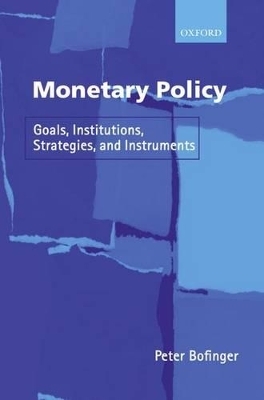
Monetary Policy
Goals, Institutions, Strategies, and Instruments
Seiten
2001
Oxford University Press (Verlag)
978-0-19-924856-8 (ISBN)
Oxford University Press (Verlag)
978-0-19-924856-8 (ISBN)
This book provides an in-depth description and analysis of monetary policy in Europe and the United States. Focusing specifically on the European Central Bank, it offers one of the first comprehensive guides to understanding the targets, strategy, and instruments of the ECB.
This book provides an in-depth description and analysis of monetary policy in Europe and the United States. Unusually for a volume in the field, it focuses on actual monetary policy---targets, institutions, strategies, and instruments---but traditional and contemporary theoretical approaches to monetary policy form the basis for each chapter. Concentrating specifically on the European Central Bank, Monetary Policy offers one of the first comprehensive guides to understanding the targets, strategy, and instruments of the ECB.
In the past, many books have presented mere descriptions of the institutional framework without providing a theoretical framework, while others have dealt mainly with theoretical aspects, thus neglecting the policy implications of their analysis. By combining a theoretical with a policy-oriented approach, Peter Bofinger succeeds in closing this gap in the monetary policy literature. As a result, his book will appeal to a broad readership, including investment bankers and other professional investors, central bankers, and scholars working in the field.
This book provides an in-depth description and analysis of monetary policy in Europe and the United States. Unusually for a volume in the field, it focuses on actual monetary policy---targets, institutions, strategies, and instruments---but traditional and contemporary theoretical approaches to monetary policy form the basis for each chapter. Concentrating specifically on the European Central Bank, Monetary Policy offers one of the first comprehensive guides to understanding the targets, strategy, and instruments of the ECB.
In the past, many books have presented mere descriptions of the institutional framework without providing a theoretical framework, while others have dealt mainly with theoretical aspects, thus neglecting the policy implications of their analysis. By combining a theoretical with a policy-oriented approach, Peter Bofinger succeeds in closing this gap in the monetary policy literature. As a result, his book will appeal to a broad readership, including investment bankers and other professional investors, central bankers, and scholars working in the field.
Peter Bofinger is Full Professor and Chair in Monetary and International Economics at the University of Wuerzburg. He is also Consultant for the European Commission, the European Parliament, the Government of Kazakstan, and the Central Bank of Uzbekistan.
1. WHAT IS MONEY? ; 5. THE ULTIMATE GOAL AND THE FINAL TARGETS OF MONETARY POLICY ; 12. IMPORTANT BUILDING BLOCKS OF OPEN ECONOMY MACROECONOMICS
| Erscheint lt. Verlag | 4.10.2001 |
|---|---|
| Zusatzinfo | 72 figures; 5 boxes |
| Verlagsort | Oxford |
| Sprache | englisch |
| Maße | 157 x 235 mm |
| Gewicht | 673 g |
| Themenwelt | Sozialwissenschaften ► Politik / Verwaltung ► Europäische / Internationale Politik |
| Wirtschaft ► Betriebswirtschaft / Management ► Finanzierung | |
| Betriebswirtschaft / Management ► Spezielle Betriebswirtschaftslehre ► Bankbetriebslehre | |
| Wirtschaft ► Volkswirtschaftslehre ► Finanzwissenschaft | |
| ISBN-10 | 0-19-924856-7 / 0199248567 |
| ISBN-13 | 978-0-19-924856-8 / 9780199248568 |
| Zustand | Neuware |
| Haben Sie eine Frage zum Produkt? |
Mehr entdecken
aus dem Bereich
aus dem Bereich
denken und handeln wie ein professioneller Trader
Buch | Softcover (2023)
Vahlen, Franz (Verlag)
CHF 51,65


